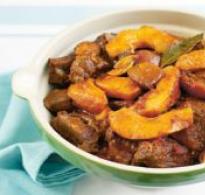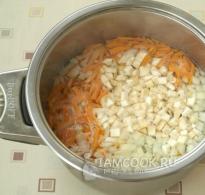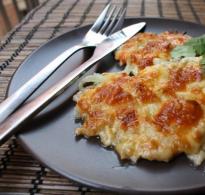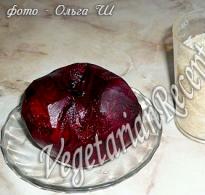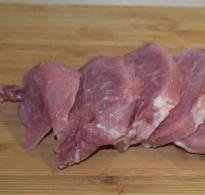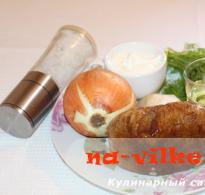Casu marzu is a rotten cheese from Sardinia. "casu marzu" - the most dangerous Italian delicacy
"Tastes are different!" says an English proverb. , which will now be discussed, unsurpassedly confirms it. And, if you experience a slight malaise from, then at the sight of Casu marzu, you are guaranteed to faint. The birthplace of Casu Marzu cheese is an island (Sardegna). In a literal translation, his name sounds like "rotten cheese." It is filled with thousands of cheese fly larvae. Surprising but true: they eat it! Many Sardinians consider casu marzu to be the best. If you are still in feelings, then let's get acquainted with the "live" cheese.
The history of casu marzu is a mystery shrouded in darkness. There is not a single date, not a single mention in historical documents. But the old-timers of Sardinia, who store information that is passed from mouth to mouth from generation to generation, claim that this product is more than one hundred years old.
There is a version that casu marzu was born as a result of an oversight during cooking. Not noticing the eggs of the cheese fly, the heads were sent for maturation, after some time they found "rotten cheese". Naturally, in times not distinguished by an abundance of products, not only conscience, but also the stomach did not allow throwing out a spoiled batch. The most courageous cheese makers took the risk of tasting it and were delighted with the new product made from sheep's milk. And so began the mass, if I may say so, production of casu marzu.

It is also assumed that the preparation of pecorino at home was always accompanied by the receipt of casu marzu, since in the summer in the villages about 50% of the heads were always affected by the larvae of the cheese fly. Therefore, with a significant degree of certainty, we can say that "rotten cheese" has a thousand-year history.
Based on health and hygiene regulations, the European Union has banned the production and sale of casu marzu. In order to protect the cheese, the Italian Ministry of Agriculture and Forestry in 2004 included it in the "list of traditional Italian foods", consisting of 4006 items. This document allows manufacturers to deviate from sanitary regulations because the product has been on the market for more than 25 years.
In addition, in 2005, some Sardinian farmers, together with members of the Faculty of Veterinary Medicine of the University (Sassari), developed and implemented the cultivation of the cheese fly (Piophila casei) in an artificial environment. Thus, manufacturers were able to fully control the manufacturing process and provide all sanitary and hygienic guarantees.
The last attempt to approve their product was the filing of an application by the Sardinian cheese makers to the European Commission for DOP status for casu marz. Today, the European Union is still adamant.
Casu marzu differs from other Italian cheeses in that it has several names: Casu frazigu, Casu becciu, Casu fattittu, Hasu muhidu, Formaggio marcio.
In 2009, it was included in the Guinness Book of Records as "the most dangerous cheese in the world." Its authors talk about the fact that the product can cause vomiting, abdominal pain and bloody diarrhea. In fact, there is no evidence of gastrointestinal disorders associated with the use of casu marzu.
How they cook
The first step in the production of casu marzu is the preparation of the DOP pecorino sardo. You can read about how sheep cheeses are prepared in our article.
Heads going to get casu marzu are kept in saline for fewer days than for pecorino. During this time, the cheese absorbs an amount of salt that does not scare away flies, but prevents the development of pathogenic bacteria.

When making small holes in the rind of the cheese, some manufacturers drop a few drops of olive oil into the holes with the dual purpose of softening the surface and attracting flies. Further, the future kasu marzu is left in open places for the “attack” by Piophila Casei. At this time, the heads are not turned over. They are stacked on top of each other when enough eggs have been deposited on the cheese to ensure the transition of the larvae from one form to another. The process of cheese fermentation by insects lasts from 3 to 6 months. Its end is determined by the number of larvae and texture, cutting off the top crust (cheese cap).
The production of casu marzu is mainly found in the villages of Sardinia and lasts from late spring to late autumn. This is the time of the most suitable temperature for the development of cheese fly larvae.
By the way, casu marzu is not the only larval cheese in Italy, but the most famous. In the vastness of the republic you can meet "Casu du quagghiu" in Calabria (Calabria), "Furmai nis" in (Emilia-Romagna), "Marcetto" in (Abruzzo), "Bross ch'a marcia" in (Piemonte).
Characteristics and methods of use
They have a cylindrical shape with convex sidewalls and flat edges and weigh from 2 to 4 kg. Depending on the number of insects, the consistency of the cheese may be thicker, pasty or soft, creamy. Aged versions have a very delicate texture with a liquid called lagrima, which means “tear” in translation. The mass is filled with translucent larvae about 8 mm long.

Kasu marzu has a sharp aroma, reminiscent of Pecorino Sardo Maturo, but much more intense. The taste is spicy, burning. The cheese leaves a long aftertaste lasting several hours.
Sardinians do not eat casa marza if the larvae in it have already died, considering such a product to be toxic.. If the cheese is ready to eat, and the consistency is still quite dense, then it is cut into slices and placed on a Sardinian flatbread (pane carasau) and served with strong red wine. Soft kasu marzu is taken out with a spoon and spread on bread.
Some people prefer to eat cheese without paying attention to the maggots. The worms are quite mobile, they jump up to 15 cm. Therefore, the Sardinians keep their hands over the sandwich to prevent them from hitting the face.
There are gourmets who get rid of insects. One method devised by tourists is to place a portion of cheese in a paper bag and seal it tightly, cutting off oxygen. The larvae begin to randomly jump, drumming on the paper. When the knocking subsides, the package is opened and the dead worms are calmly removed.
It is worth noting that the inhabitants of the island, considering kasu marza an excellent delicacy, often serve it on holiday tables for weddings and birthdays.
Calorie content, benefits and possible harm
The exact nutritional value of casu marzu is unknown. Knowing that cheese is made from whole sheep's milk, you can limit the range of its calorie content from 350 to 400 kcal per 100 g.
Of course, like any cheese, casu marzu is a source of proteins (essential building blocks for the body) and calcium, which is necessary for the health of bones, teeth, muscles and the conduction of impulses of the nervous system.
In Sardinia, they say that "rotten cheese" is an excellent aphrodisiac, that is, it increases sexual desire.
Often you can find information about the dangers of cheese, which consists in:
- Allergic reactions;
- Toxic poisoning;
- intestinal infections;
- Damage to the stomach and intestinal walls.
However, it should be noted that there is not a single documentary evidence of such consequences. Everything is based only on the assumptions of epidemiologists.
Price in Italy
You won't be able to buy casa marza just by arriving in Italy and going to any grocery store. The sale of cheese is prohibited, so you need to look for it on the so-called "black market". To feast on them, you will have to travel to distant villages. Only there your search can be crowned with success, while it is possible to buy it at a price twice the price of pecorino - 30-50 Euro per kg. Here he is - a "rotten delicacy"!

Now you have enough information at your disposal to decide for yourself whether to eat "rotten cheese". If you like to be surprised and surprise, or an extreme gourmet lives in you, then you simply need a vacation in Italy. Live experiences, love beautifully, travel the Italian way and remember: "What doesn't kill us makes us stronger!" Ah yes, to Sardinia for eternal youth!
↘️🇮🇹 USEFUL ARTICLES AND SITES 🇮🇹↙️ SHARE WITH YOUR FRIENDS
Letters from ZATEEVO's friends.
The letter was sent by Kitya Karlson, Canada.
Kitya Karlson graduated in 2000 from the Faculty of Computational Mathematics and Cybernetics of Lomonosov Moscow State University. And, since "programmers" are taught well here, and Kitya Karlson himself learned English at school, he was invited to work in a Japanese company. Seeing the world is always interesting. Therefore, Kitya Karlson was happy to work as a programmer, first in Japan, then in Australia, and now he lives and works in Canada.
Do you know what unites all nations in the world? Cheese love! Tastes are definitely different. But there are so many cheeses in the world that there is a favorite for everyone.
Usually tourists are warned about the dangers that await them in a foreign country. So I want to warn you - ABOUT CHEESE!

If you studied geography at school, or at least once in your life saw a map of the world, then you probably know that Italy is similar in shape to a boot. And the neighboring Mediterranean island of Sardinia looks like it just got a boot on the bulldozer from Italy. Moreover, I know why. Sardinia gave the world one of the most delicate and most dangerous cheeses - Casu Marzu.
Every cheese lover knows that the main thing in cheese is aging. Most soft cheeses are aged under different conditions from several days to several years of slow milk fermentation, fat breakdown, oxidation and growth of the most delicate, delicious mold on a soft milk pillow, a flowing, weeping cheese.
But only on the island of Sardinia this concept was taken one step further: cheese made from fresh sheep's milk is aged there for three months, during which people plant female cheese fly piophila casei on pieces of cheese, which lay larvae in milk.

Thousands of small, about 8 millimeters, translucent worms begin to eat the cheese, and a new liquid "lagrima", from the Italian word for "tears", begins to appear in the milk, making the texture of the cheese softer and softer. The originality of the result lies in the fact that such cheese can be deadly to humans in two cases:
- with dead worms, because of the danger of infection with cadaveric poison,
- with live worms, since the larvae of the cheese fly are resistant to gastric acid and, accordingly, continue to live in the stomach and intestines even after eating cheese.
Not surprisingly, such cheese in Sardinia is considered extremely healthy and costs a lot of money.
 Naturally, I never ate Kasa Marzu myself. However, this is not the only cheese with living creatures. One of my truly favorite hard cheeses is Mimolette. Mimolette is not at all as exotic as Casu Marzu and is freely sold almost all over the world, so I hope each of you will know someday its wonderful taste. The most delicious thing about this orange hard cheese is its porous, slightly grayish crust. This crust is the poop of cheese mites (among which they themselves run), tiny arachnids specially bred on this cheese, which can only be seen under a microscope.
Naturally, I never ate Kasa Marzu myself. However, this is not the only cheese with living creatures. One of my truly favorite hard cheeses is Mimolette. Mimolette is not at all as exotic as Casu Marzu and is freely sold almost all over the world, so I hope each of you will know someday its wonderful taste. The most delicious thing about this orange hard cheese is its porous, slightly grayish crust. This crust is the poop of cheese mites (among which they themselves run), tiny arachnids specially bred on this cheese, which can only be seen under a microscope.


Of all the places in the Canadian city of Vancouver, near which I now live, there is only one that I visit with enviable regularity - the Granville market. As I have already noticed, the North American approach to nutrition is quite different from the European one, but the Granville market is the very place where you can find delicacies imported from Europe and Asia: cheeses and sausages from France, sweets and rare fruits from Israel, and much, much more. . There is, though scarce, though expensive, but fortunately for me there are also refugee cheeses that are illegally in Canada, officially banned for consumption in North America for security reasons. For some mysterious reason, many French cheeses made from fresh, unpasteurized milk seem like pure poison to local officials. But we know better, right?

In my favorite, and in fact the only French cheese shop there, I also saw a small piece of an old mimolette. The grey, porous crust, swarming with invisible mites, was gone, having been carefully cut off on all sides with a knife. Now I can’t understand everything, either the customs didn’t let the ticks in, or the seller himself ate everything delicious!
The most elite and most expensive coffee in the world is a product that came out of the intestines of a predatory animal of the genus civet. The “pits” of the grains are taken from the excrement of palm civet, washed and dried in the sun. The processed digestion product of a small predatory animal has a pleasant chocolate aroma.
Price: $600 per pound (about 500 grams)
Salangan bird nests

One of the most important delicacies in China has become the nests of salangan birds, the males of which spend whole days for several months working on their construction, building them entirely from their saliva. Due to the long time it takes to build one nest, the cost of them is quite big. The nests themselves are considered tasteless, but they are often added to soups, and most importantly, they have many medicinal qualities. This delicacy is served by tons to gourmets from different countries.
Price: from 1,000 to 10,000 dollars per kg
Argan oil

Moroccan wild goats have learned to climb trees to get the wonderful fruit of the argan tree. The animal eats the fruits, and the only thing left for the farmers to do is to collect the digested bones in their droppings. As a result, from these seeds a golden-hued oil is obtained, known for its healing properties. In addition, cosmetologists often add oil to various creams: to smooth wrinkles, moisturize, strengthen hair roots and against burns. In a word, not only doctors and cosmetologists were convinced of its merits, but also goats who learned to climb trees for the sake of the fruits of the treasured argan.
Price: $120 per liter
Kasu marzu cheese

It is an Italian delicacy from Sardinia, where its production is illegal. From the Sardinian Casu Marzu is translated as "rotten cheese", and this name went to him for a reason. Casu marzu is aged longer than the normal fermentation stage, bringing it to a state of decay. In this state, cheese flies take over it, laying their larvae in it. The larvae are almost centimeter-long worms that, moving through the cheese, secrete special enzymes that give it an even sharper smell, rotten taste, and a soft, creamy texture. They often like to treat themselves to decomposing cheese at weddings or other family celebrations.
Price: $100 per pound (500 gr)
snake wine

This Vietnamese delicacy is made in front of the restaurant's guests. The visitor is approached by a snake-breeder with a cobra, followed by an assistant with a metal tray, a small bowl, a decanter of rice wine and a pair of garden shears in his hands. After the general meeting, the process of killing the reptile follows, more precisely, cutting the belly with scissors. Dark snake blood is mixed with rice wine and offered to the visitor. "Ru tiet ren", snake wine, a gourmet must eat the still beating heart of a cobra. This whole procedure is accompanied by a tasting of the remaining insides of an evil snake. Locals believe that snake blood has healing properties and contributes to replenishment in the family.
Price: $21 per glass
Fugu fish

Trying puffer fish sashimi in Japan requires a fair amount of courage and excitement. Under the seemingly harmless name of fugu, there is a fish deadly to humans with a huge amount of poison inside. Therefore, only cooks who have special licenses for this and are able to measure exactly as much poison as a person needs for drug intoxication are allowed to cook it. Peculiar sensations after taking fugu cost visitors a pretty penny.
Price: $300 per kg
Balut

Balut is an essential part of every Filipino's daily diet. This dish is not only credited with miraculous properties, but also a very real effect on potency. What determines the demographic situation in the Philippines? Balut is simply a duck egg boiled in salt water. Only now a fully formed embryo of a duck with plumage and a barely visible beak will be cooked. In addition to the Filipinos, this dish is also practiced in other countries of Southeast Asia. The egg is best eaten with vinegar, as the boiled duck has a very specific taste. To tell the truth, this is not a sight for the faint of heart, although Filipino husbands like to look at the buds of feathers and pleasantly crunch on the barely formed bones of a small duck. Some people are so eager to eat balut that the egg is eaten raw, seasoned with a fair amount of salt and pepper.
Price: less than a dollar an egg
Ant caviar (Escamoles)

When unsuspecting black ants of the genus Liometopum lay their eggs in agave roots in Mexico, they are already being hunted. Just before the larvae are supposed to hatch, they are harvested and prepared from them the most real and very expensive delicacies. Collecting these larvae is not an easy task, one cannot do without protective clothing, since the relic species of ants, included in many Red Books, protects their offspring by releasing a poison dangerous to humans. As for the taste of the larvae, they are quite edible, and in their constitution, ant eggs are similar to cottage cheese. Most often, all the ants go to the Mexican Taco salad.
Price: $40 per pound (500 grams)
As you know, there is no arguing about tastes, and the cheese that will be discussed demonstrates this perfectly. Casu marzu ("rotten cheese") is made in Sardinia, where it is considered a real delicacy. The peculiarity of this product is that inside it there are thousands of larvae of cheese flies. How the recipe for “live” cheese appeared is unknown, because nowhere is there a single date, not a single document mentioning the creation of the casu marzu recipe. But there is a version that the “rotten cheese” turned out by accident, when the technology for making pecorino cheese was not followed. The cheese was sent to ripen without noticing the eggs of the cheese fly. Of course, hundreds of years ago, throwing away food was an unaffordable luxury, so the most courageous decided to try the "gastronomic novelty" and ... were delighted with the new cheese made from sheep's milk. From that moment on, they began to produce such cheese in large quantities.
By the way, the European Union has banned the production and sale of this type of cheese, based on sanitary standards. But the Ministry of Agriculture and Forestry of Italy in 2004 decided to stand up for cheese and added it to the "list of traditional Italian products." The document allows you to not exactly follow sanitary standards. And in 2005, some farmers from Sardinia, in collaboration with veterinarians from the faculty of the University of Sassari, initiated the breeding of cheese fly in artificial conditions. But the EU is adamant. In 2009, "rotten cheese" entered the Guinness Book of Records as the most dangerous in the world. Although the authors claim that its use can provoke vomiting and indigestion, there is not a single official confirmation of this.
Express info by country
Italy(Italian Republic) is a state in Southern Europe.

Capital - Rome
Largest cities: Rome, Milan, Naples, Turin, Palermo, Bologna, Florence, Catania, Venice
Form of government- Parliamentary republic
Territory- 301,340 km 2 (71st in the world)
Population– 60.79 million people (23rd in the world)
Official language– Italian
Religion - Catholicism
HDI - 0.873 (27th in the world)
GDP– $2.141 trillion (8th in the world)
Currency– euro
Borders with: France, Switzerland, Austria, Slovenia
Cooking
First, pecorino sardo (sheep's milk cheese) is prepared. The heads are then soaked in saline, but for fewer days than for pecorino. During this period, the cheese takes so much salt so as not to scare away the cheese flies and prevent bacteria from multiplying. Next, a small hole is made in the cheese, where a little olive oil is poured, which attracts flies and softens the cheese. Then it is left in open places without turning the head. Fermentation of cheese by larvae lasts from 3 to 6 months. Kasu marzu is produced mainly in villages from late spring to late autumn.
As it is
Ready cheese has convex sidewalls, flat edges and leads from 2 to 4 kg. The consistency of casu marzu is affected by the number of insects (thick, soft or pasty). The mass is filled with larvae about 8 mm long. The taste is burning and spicy, the cheese has a sharp aroma. The Sardinians consider the product to be toxic and do not eat it if the worms have died. Kasa marzu with a denser texture is cut into slices and placed on a flatbread, while soft marzu is spread on bread or eaten with a spoon. Worms are active and jump up to 15 cm. Therefore, when eating, the Sardinians cover the sandwich with their hand. Tourists also came up with a method of getting rid of the larvae. The cheese must be placed in a paper bag, blocking the access of air, and shake vigorously. Worms die - and you can eat cheese without them. "Rotten cheese" is, like any other, an excellent source of protein and calcium.

Cost in Italy
The sale of cheese in stores is prohibited, so you need to look for it on the "black market". To do this, you need to visit the distant villages of Sardinia. You will be offered this delicacy for €30-50 per kilo.
Back in Roman times, cheese was a popular and everyday staple. Today, a rare table is complete without cheese, but cheese is different for cheese. The huge difference in quality and price forces us to separate the industrial product sold in every supermarket and the homemade cheeses of the highest grades that only very wealthy gourmets can afford.
Mass production of cheese began in 1815 when the first factory in Switzerland opened. Cheese has become an affordable product, but elite varieties have not left the gastronomic arena, but, on the contrary, have become even more valued as an exquisite delicacy that gives the table a special status. These most expensive types of cheese in the world symbolize wealth and aristocratic taste, which is why they usually cost fabulous money.
What does the price depend on?
The cost of the most expensive cheese in the world is determined not so much by its taste, but by the quantity of production. The less cheese produced, the more expensive it is. Therefore, the most expensive cheeses in the world, whose names you will learn in the process of reading the article, are made on home farms and in private reserves. To date, more than 400 types of homemade cheeses exist in France and more than 700 in England.
Also the price of this product depends on its components. After all, not only cow or goat milk is used in its manufacture. There is cheese made from elk milk and donkey milk. These varieties are considered among the most expensive in the world. Like good wine, cheese is valued for its age. Some varieties ripen as much as 10 years! Of course, their value from this only increases.
List of the most expensive cheeses in the world
What are the most expensive cheeses in the world? These include the following:
- moose milk cheese;
- donkey milk cheese ("Pule");
- "Horse Cheese" (Caciocavallo Podolico);
- "Golden Cheese" (Clawson Stilton Gold);
- "Kasu Marzu" (rotten cheese with worms).
Now it is worth considering each of these varieties separately.

Moose milk cheese
In Bjurholm (Sweden), the Elk House farm creates amazing cheese from elk milk, the price of which starts at $455 per pound (850 euros per 1 kg). A married couple of farmers Krester and Willa Johansson keep three moose calves on the farm. Moose cows give very little milk - some 300 liters per year, because they are milked only in summer: from July to August.
The process of milking one elk takes a lot of time. Sometimes, to get 2 liters of milk, you need to spend at least 3 hours near an elk. Moose milk is much fatter than cow's milk and contains more zinc, iron, aluminum, and selenium. Therefore, Elk House cheese is very fatty, although it resembles feta in texture.
According to gourmets, it has a delicate salty taste. By the way, moose milk is not as sweet as cow's milk. Farmer's Johansson cheese is served at Algen Hus, a Swedish restaurant. Another type of moose milk cheese is produced at the Moose House farm in Switzerland. Its production is limited to about 200 kg per year, and the price starts at 800 euros per kilogram.

Donkey milk cheese
Cheese "Pule" is made from the milk of Balkan donkeys. It is one of the most expensive cheeses in the world. Its price starts from 1000 euros per kilogram, and it is explained not only by the rich taste of this variety, but also by exclusivity. The fact is that about 100 female Balkan donkeys provide milk for Pule cheese. And it takes 25 liters of milk to produce 1 kilogram. Considering that one donkey gives an average of 200 ml of milk per day, one can understand why it costs about 40 euros per liter. Thus, the release of "Pulet" is limited, and besides, its manufacturers have no competitors in the modern world.
This product is made only on the farm of the Zasavica reserve, which is located in Serbia, in Belgrade. It also produces donkey milk in bottles, from which this very cheese is made. It was from this milk, according to legend, that Cleopatra took baths.
Donkey milk is the only ingredient in Pule cheese. Therefore, it is distinguished by its white color and crumbly consistency. To taste, according to those who were lucky enough to try it, the delicacy resembles the Spanish variety "Manchego" from sheep's milk, which has a spicy, salty taste. Manchego costs several times cheaper: $20 per kilogram, but experts note that the taste of Pule is deeper and nobler.
In 2012, in England, at the annual Somerset Cheese Fair, Poole cheese was sold for $1,275 per kilogram, and this was recorded as a world record for the cost of cheese. However, very soon this record was broken by "Horse Cheese" - Caciocavallo Podolico.

"Horse Cheese"
The average price of Italian cheese Caciocavallo Podolico is 1250 euros per kilogram. Its name translates literally as "horse cheese", but horses have nothing to do with the production of this variety. Podolico, which translates as "horse", is the name of a very rare breed of cows that are bred in southern Italy.
In summer, these animals feed on wild berries in the mountains: blueberries, strawberries, cherries, hawthorn, and this gives Caciocavallo Podolico cheese a sweetish taste and an exquisite fruity aroma. This fact has been noted by true cheese connoisseurs and tasters. This variety is also notable for the fact that it is made exclusively by hand, and only from seasonal milk - May and June. It takes 5 to 8 years to mature.

golden cheese
The unique Clawson Stilton Gold cheese can be called gold without reservation, because its decorations are made of 24 carat gold flakes. It is based on the highest grade Stilton cheese, and real golden liquor and edible gold foil are exquisite additives, thanks to which the price of such cheese is 850 euros per kilogram.
Elite cheese with gold is produced by the UK company Long Clawson Dairy, which is located in Leicestershire. According to the company, this unique variety is in high demand. Its taste is bright, rich, incomparable with anything. Pop stars, oil sheiks and other world celebrities can order golden cheese for a casual dinner.

Rotten cheese with worms
Italian cheese "Casu Marzu" is one of the most unusual varieties in the world. Its name literally translates as "rotten cheese", and there is a reason for this. After all, the putrid smell and strength of the taste of this cheese are the result of decomposition, which is accelerated by popiophile larvae.
The basis of Kasu Marzu is Pecorino sheep cheese, in which the larvae are settled. There is a special technology for cleaning cheese from worms, because when they die in cheese, they make it toxic and poisonous. It is for this reason that Casu Marzu is a prohibited product in the EU countries. According to experts, it can cause not only poisoning with an intestinal infection, but also a serious allergic reaction. Nevertheless, cheese is produced in Sardinia, despite fines and bans, and successfully finds its buyer.
"Casu Marzu" is not sold in stores and is not served in restaurants openly, but it can be purchased in the "black markets" in the villages of Sardinia or through acquaintances from the locals. This variety in 2009 was listed in the Guinness Book of Records as "the most dangerous cheese on the planet."
People who have tasted this most expensive cheese in the world with worms say that it is characterized by a sharp, bright aroma and a burning, spicy taste that lasts for several hours in the mouth. Some gourmets advise eating cheese without paying attention to worms, and those who are squeamish put the cheese in a tight plastic bag. It is worth waiting until the worms stop moving. Then you need to expand the package and remove the dead larvae.

The most expensive cheese ever
At the moment, a record price for cheese has been fixed: 6300 euros for half a kilogram of sheep's cheese. What kind of product is worth that kind of money, you ask? In fact, this type of cheese costs no more than 70 euros per kilogram. But in 2007, at an auction in Spain, a local restaurateur decided to pay such an unjustified price in order to advertise his establishment.
most expensive cheese platter
Another price record is a Frome Cheese Platter sold at the Somerset Cheese Show for $3,300. The most exquisite and expensive cheeses were presented on a wooden dish: the above-described "Poulet" and a variety of "Cheddar" called Wyke Farms Vintage. The latter is a white truffle-flavored cheese, and its price starts at $500 per kilo.
The cheeses were served with gilding and truffles on a silver tray with a bottle of quality expensive wine.

